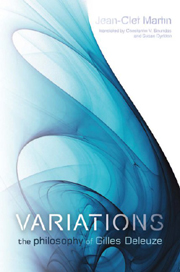Book contents
- Frontmatter
- Contents
- Letter-Preface by Gilles Deleuze
- Preambles
- First Variation: Ethics and Aesthetics
- Second Variation: Three Poetic Formulas for Nomadic Distribution
- Third Variation: Multiplicities
- 1 The Image of Thought
- 2 Variations
- 3 Poetics of Multiplicities
- Fourth Variation: Malcolm Lowry, or, the Manifesto of Things
- Postscript to the Anglo-American Edition: What is a Multiplicity?
- Notes
- Bibliography
- Index
2 - Variations
from Third Variation: Multiplicities
Published online by Cambridge University Press: 12 September 2012
- Frontmatter
- Contents
- Letter-Preface by Gilles Deleuze
- Preambles
- First Variation: Ethics and Aesthetics
- Second Variation: Three Poetic Formulas for Nomadic Distribution
- Third Variation: Multiplicities
- 1 The Image of Thought
- 2 Variations
- 3 Poetics of Multiplicities
- Fourth Variation: Malcolm Lowry, or, the Manifesto of Things
- Postscript to the Anglo-American Edition: What is a Multiplicity?
- Notes
- Bibliography
- Index
Summary
With each new beginning, Deleuze's philosophy ramifies and fragments itself around a question that reengages a labyrinth of problems, wherein the echo of multiplicities resonates. The conquest of multiplicities does not attempt to emulate Hegel by reducing the totality of the real to a uniform play of the one and the many, the same and the other. The rhizomatic logic of multiplicities leads Deleuze to a multilinear conception of thought that – far from compartmentalizing itself within autonomous sectors, and circles of circles – produces folds, pleats and lines of flight that bring aesthetics, philosophy, ethics and science together within a mobile territory.
In the encyclopaedia of a cyclopean odyssey, it is necessary to establish the lines of flight for a geographic becoming, for walk and thought, for topological courses and networks of neurons. Thought may toss the dice into the snares of fibrous material, but not according to the model of exemplification. The mobility of the ritornello and its power of propagation do not follow the repetition of examples. Rhythm and milieus in architecture do not designate a model whose examples are philosophy and painting. There are architectural, literary and philosophical ritornellos without common borders. The rhythm of music is not the rhythm of poetry or philosophy and the places it travels to do not share the same nature. Thought, no less than architecture, counts its own spheres and dynamisms. Each philosophy establishes a rhythm, releases a spiritual automaton in a purely descriptive material and may correspond to the rhythms of music, painting or architecture.
- Type
- Chapter
- Information
- VariationsThe Philosophy of Gilles Deleuze, pp. 146 - 161Publisher: Edinburgh University PressPrint publication year: 2010



